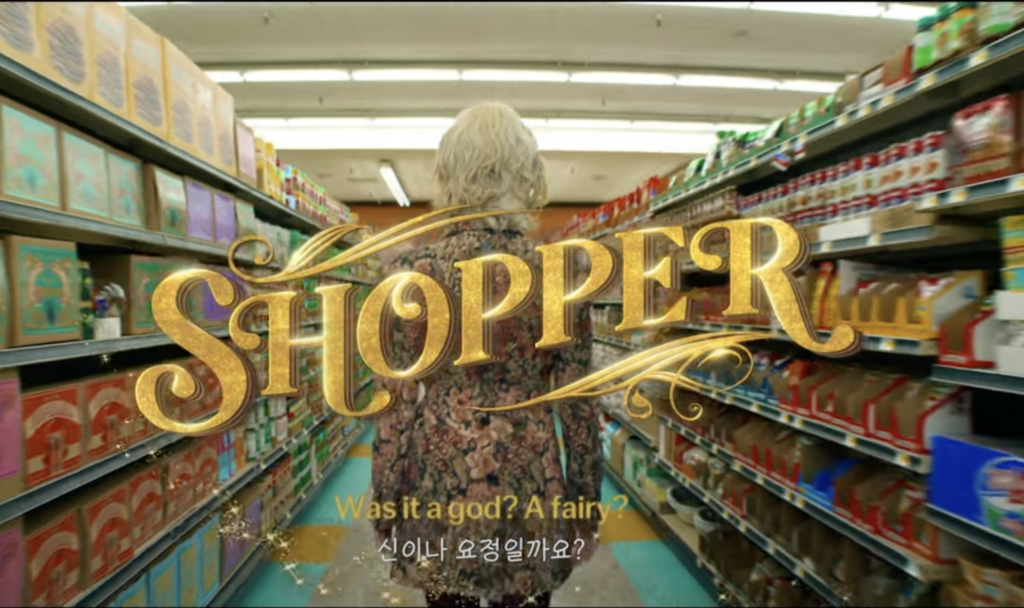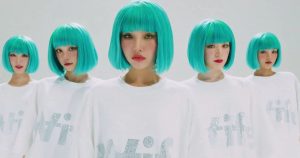IU has released The Winning, her first album since she entered her 30s. In her promotions, she discusses her contentment with her creative freedom and ambition at this age. “Shopper,” the electro-pop title track, encapsulates the main theme IU wishes to explore in her early 30s. “Shopper” may appear at first to valorize materialism, but it ultimately encourages people to pursue their dreams in a way that feels expansive and exuberant.
In a video interview about The Winning, IU unapologetically asserts that she is an ambitious person. She validates owning our desires, because we tend to downplay our dreams in favor of practical matters – even children, who should have the “privilege of absurd dreams.” Speaking about the message of “The Shopper,” she comments, “When I talk about my dreams, ambition, even if others say, ‘Your dream sounds absurd,’ ‘You’re an oddball,’ ‘You seem too greedy’… ‘Let’s desire confidently.’ That’s what I wanted to say.”
Through its visuals and storytelling, “Shopper” recovers the “privilege of absurd dreams” that we have lost. With a voiceover from DPR Ian narrating, “There once was a shop”, the MV is framed like a fairy tale or children’s story. Like many tales geared toward youth, the video introduces magical elements, such as an envelope that glows with glittering dust around it. When the lights come on in the shop, chimes in the background play a melody reminiscent of the main theme from the Harry Potter film series. The video’s Shopper logo contains a gold font similar to the one from Willy Wonka and the Chocolate Factory. The beginning of the MV thus portrays a world of whimsy and enchantment.
In addition to starring as the narrator and as IU’s partner in her journey, DPR Ian directed the MV. He and IU may at first seem like a surprising collaboration, but he lends his own aesthetic sensibility in a way that fits this MV perfectly. In his own MVs (such as “Don’t Go Insane”), he incorporates super-saturated colors and otherworldly elements that also work well within “Shopper”; its fantasy world benefits from the hint of surrealism also found in DPR Ian’s visual artistry.
Furthering the storybook quality, the MV is structured episodically. Each verse, set to a grooving synth loop, depicts the beginning of a quest marked on a magical map that IU holds. The first verse, for instance, is set in a Midnight Auction held in a theater. The auction feels chaotic, with people rowdily jumping out of their seats, yelling and holding up signs reading “I Want This” as they bid on objects. One can catch a glimpse of auction attendees forcing down the hands of others who want the same prizes. Once the pre-chorus hits, the synths fall away, signaling a shift in the narrative. In this first scene, IU stands up, leaves the hall, and flips a breaker to cut off the lights.
The problems that IU encounters are largely resolved by the time the chorus arrives. In the first verse, she finds a way to take the auction items she desires, while also serving as a quasi-Robin Hood figure, throwing cash around the room. In the second verse, she and DPR Ian get away in his car, but it breaks down. The location turns out to be only a short distance away from the second spot marked on the map: a fireworks shop. When the uplifting chorus comes, IU’s soaring melody is punctuated with an electric guitar chord. As that chord hits each time, the MV cuts to some kind of explosion: money strewn through the air, or fireworks going off. The cuts make sense narratively, and also help create a burst of joy that these moments intend.
The final chorus heightens the MV to an even higher celebratory note, first depicting a party at IU and DPR Ian’s hotel, with IU splitting open a piñata with the golden bat she pilfered from the Midnight Auction. The MV then cuts to jubilant shoppers running down the aisles of the supermarket that was also shown at the beginning of the video. The imagery returns to the desire for material goods portrayed in the first half of the MV, suggesting the happiness that comes from obtaining them.
The song’s conflation of dreams with materialism, or ambition with greed , might seem questionable, but “Shopper” is not remotely interested in exploring moral or sociological implications of consumption. Rather, responding to how she has been called “greedy” for having bold ambitions, IU reclaims greed as a metaphor for personal aspirations. In her world, people should embrace their desires like they did as children.
“Shopper” goes all-in with an optimistic mindset of abundance: dreams, whether they are for physical or abstract things, are available to everyone. IU sings in the chorus:
Let’s go haul
Fill it up to make it burst
Look around
Time is short, make ‘em all yours
This shop will never close, look
As her lyrics suggest, the shop will continue to reward people as long as they can imagine possibilities and pursue their dreams. By the end, IU’s multi-colored, confetti-filled world is teeming with people who obtain what they want and find joy.
One easily feels a similar sense of glee while watching “Shopper.” The acting feels looser near the end, and perhaps is not acting at all, but the cast members having fun. The MV ends with a credits sequence featuring outtakes, but even the main video includes some goofy moments, like IU laughing while DPR Ian falls off a bed.
“Shopper” represents what IU does best and where she is at this stage in her career. She owns her ambitions, while also believing that everyone can attain their dreams. Through her music and video, she spreads not only this philosophy, but also self-confidence, wonder, and joy.
(YouTube [1][2]. Lyrics via Genius. Images via Edam Entertainment).




